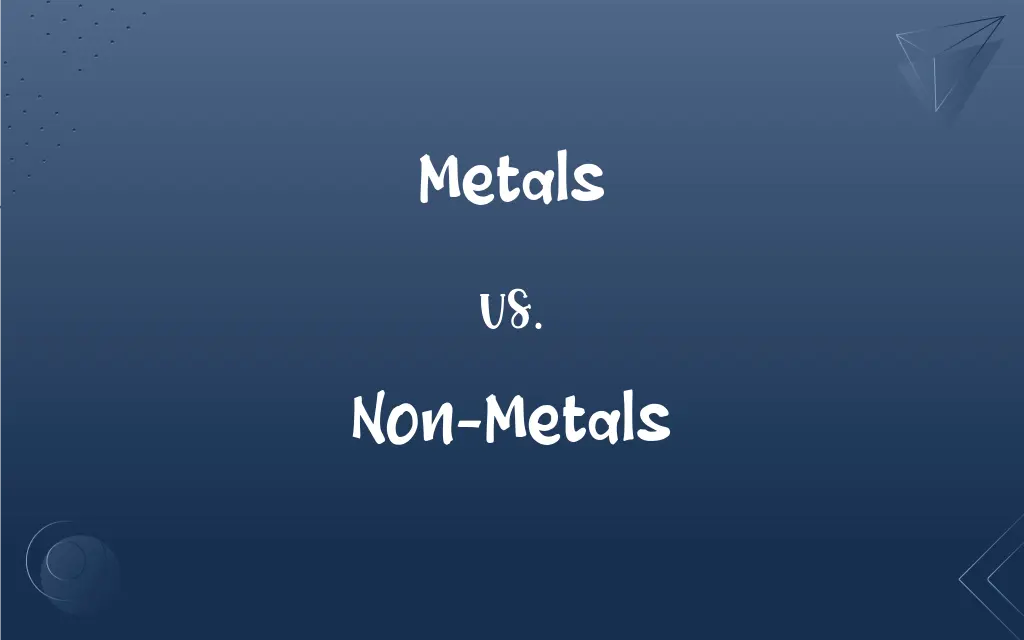Metals vs. Non-Metals: What's the Difference?
Edited by Harlon Moss || By Janet White || Published on October 7, 2024
Metals are elements with high conductivity, malleability, and luster, while non-metals are diverse elements, generally with lower conductivity and lacking metallic luster.

Key Differences
Metals are known for their ability to conduct electricity and heat efficiently, whereas non-metals typically have poor conductivity. This fundamental difference is due to the way electrons are arranged and interact in these elements.
In terms of physical properties, metals are often malleable and ductile, meaning they can be shaped or stretched without breaking. Non-metals, on the other hand, are usually brittle in solid form and cannot be molded or drawn into wires.
Metals generally have a shiny, metallic luster, while non-metals do not exhibit this characteristic. The appearance of metals can be strikingly different from the varied and often duller appearances of non-metals.
Metals tend to have high melting and boiling points, indicative of strong bonds between atoms. Non-metals, in contrast, may have lower melting and boiling points, with some existing as gases at room temperature.
Chemically, metals usually lose electrons to form positive ions, whereas non-metals tend to gain electrons to form negative ions. This difference in electron behavior underlies many of the chemical reactions involving metals and non-metals.
ADVERTISEMENT
Comparison Chart
Conductivity
High (good conductors)
Low (poor conductors)
Physical State
Mostly solid (except mercury)
Solid, liquid, or gas
Malleability and Ductility
Malleable and ductile
Brittle in solid form
Appearance
Shiny, metallic luster
Lacks metallic luster
Chemical Behavior
Lose electrons to form cations
Gain electrons to form anions
ADVERTISEMENT
Metals and Non-Metals Definitions
Metals
Metals are elements that are good conductors of heat and electricity.
Copper wires are used extensively due to the metal's excellent conductivity.
Non-Metals
Non-metals are not malleable or ductile.
Sulfur, a non-metal, breaks easily into a powder.
Metals
Metals are malleable and can be hammered into thin sheets.
Gold, a highly malleable metal, is often used in fine jewelry.
Non-Metals
Non-metals are elements with poor conductivity of heat and electricity.
Rubber, a non-metal, is used for insulation due to its poor conductivity.
Metals
Metals are ductile, meaning they can be drawn into wires.
Aluminum, a metal, is widely used to make lightweight, durable wires.
Non-Metals
Many non-metals have low melting and boiling points.
Bromine, a non-metal, is liquid at room temperature.
Metals
Metals typically form positive ions in chemical reactions.
In reactions, sodium, a metal, readily loses an electron to form a positive ion.
Non-Metals
Non-metals can be solid, liquid, or gas at room temperature.
Oxygen, a gaseous non-metal, is essential for respiration.
Metals
Most metals have a high melting point.
Steel, an alloy of metals, has a high melting point, making it ideal for construction.
Non-Metals
Non-metals typically form negative ions in chemical reactions.
Chlorine, a non-metal, gains an electron to form a negative ion in reactions.
Metals
Any of a category of electropositive elements that usually have a shiny surface, are generally good conductors of heat and electricity, and can be melted or fused, hammered into thin sheets, or drawn into wires. Typical metals form salts with nonmetals, basic oxides with oxygen, and alloys with one another.
Non-Metals
Plural of non-metal
FAQs
Can non-metals be found in all three states of matter?
Yes, non-metals can be solids, liquids, or gases at room temperature.
Are all metals solid at room temperature?
Except for mercury, most metals are solid at room temperature.
What is a common property of metals?
Metals commonly have high electrical and thermal conductivity.
Do non-metals conduct electricity?
Non-metals generally have poor electrical conductivity.
Can metals form ions easily?
Metals tend to lose electrons easily to form positive ions.
What defines a metal?
A metal is an element known for conductivity, malleability, and metallic luster.
Are non-metals reactive?
Some non-metals are highly reactive, like fluorine and chlorine.
What are non-metals?
Non-metals are elements, diverse in properties, generally poor conductors.
Are metals good heat conductors?
Yes, metals are typically good conductors of heat.
Are metals reactive?
Many metals are reactive, some more than others.
Can metals be hammered into shape?
Yes, metals are generally malleable.
How do non-metals react to heat?
Non-metals generally conduct heat poorly.
What about the melting points of non-metals?
Non-metals often have lower melting points, some being gases at room temperature.
What is the appearance of non-metals?
Non-metals do not have a metallic luster and vary in appearance.
What is an example of a metal?
Iron is a common example of a metal.
Are non-metals malleable?
Non-metals are usually brittle and not malleable.
Do non-metals form ions?
Non-metals usually gain electrons to form negative ions.
Can you name a non-metal?
Carbon is a well-known non-metal.
Do metals have a high melting point?
Most metals have high melting points.
Do metals have a shiny appearance?
Metals typically have a shiny, metallic luster.
About Author
Written by
Janet WhiteJanet White has been an esteemed writer and blogger for Difference Wiki. Holding a Master's degree in Science and Medical Journalism from the prestigious Boston University, she has consistently demonstrated her expertise and passion for her field. When she's not immersed in her work, Janet relishes her time exercising, delving into a good book, and cherishing moments with friends and family.
Edited by
Harlon MossHarlon is a seasoned quality moderator and accomplished content writer for Difference Wiki. An alumnus of the prestigious University of California, he earned his degree in Computer Science. Leveraging his academic background, Harlon brings a meticulous and informed perspective to his work, ensuring content accuracy and excellence.






































































